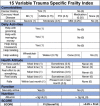The 2023 WSES guidelines on the management of trauma in elderly and frail patients
- PMID: 38816766
- PMCID: PMC11140935
- DOI: 10.1186/s13017-024-00537-8
The 2023 WSES guidelines on the management of trauma in elderly and frail patients
Abstract
Background: The trauma mortality rate is higher in the elderly compared with younger patients. Ageing is associated with physiological changes in multiple systems and correlated with frailty. Frailty is a risk factor for mortality in elderly trauma patients. We aim to provide evidence-based guidelines for the management of geriatric trauma patients to improve it and reduce futile procedures.
Methods: Six working groups of expert acute care and trauma surgeons reviewed extensively the literature according to the topic and the PICO question assigned. Statements and recommendations were assessed according to the GRADE methodology and approved by a consensus of experts in the field at the 10th international congress of the WSES in 2023.
Results: The management of elderly trauma patients requires knowledge of ageing physiology, a focused triage, including drug history, frailty assessment, nutritional status, and early activation of trauma protocol to improve outcomes. Acute trauma pain in the elderly has to be managed in a multimodal analgesic approach, to avoid side effects of opioid use. Antibiotic prophylaxis is recommended in penetrating (abdominal, thoracic) trauma, in severely burned and in open fractures elderly patients to decrease septic complications. Antibiotics are not recommended in blunt trauma in the absence of signs of sepsis and septic shock. Venous thromboembolism prophylaxis with LMWH or UFH should be administrated as soon as possible in high and moderate-risk elderly trauma patients according to the renal function, weight of the patient and bleeding risk. A palliative care team should be involved as soon as possible to discuss the end of life in a multidisciplinary approach considering the patient's directives, family feelings and representatives' desires, and all decisions should be shared.
Conclusions: The management of elderly trauma patients requires knowledge of ageing physiology, a focused triage based on assessing frailty and early activation of trauma protocol to improve outcomes. Geriatric Intensive Care Units are needed to care for elderly and frail trauma patients in a multidisciplinary approach to decrease mortality and improve outcomes.
Keywords: Ageing; Antibiotics; Delirium; Direct oral anticoagulants management; Elderly; End of life; Frailty; Geriatric patient; Imaging; Laboratory test; Pain control; Palliative care; Resuscitation; Thrombo-prophylaxis; Trauma management; Trauma score; Vitamin K antagonists anticoagulants management.
© 2024. The Author(s).
Conflict of interest statement
All authors are Editorial Board members of World Journal of Emergency Surgery, and were excluded from the peer review process for this article.
Figures
References
-
- Halaweish I, Alam HB. Changing demographics of the American population. Surg Clin North Am 2015;95(1):1–10 [Grabo, D. J., B. M. Braslow, and C. W. Schwab. "Current therapy of trauma and surgical critical care." Elsevier (2016) - PubMed
-
- ec.Europa.EU/Eurostat/statistics-explained/index.PHP title=Population_structure_and_ageing
-
- Grabo DJ, Braslow BM, Schwab CW. Current therapy of trauma and surgical critical care. In: Asensio JA, Trunkey D, editors. 2nd edition. Elsevier; 2016.
-
- The Department of Health and Human Services, Administration on Ageing. Projected future growth of the older population. Available at: http://www.aoa.gov/ aoaroot/aging_statistics/future_growth/future_growth.aspx#age. Accessed July 20, 2012.




